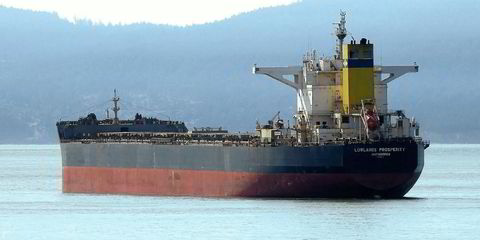Japanese shipping giant Mitsui OSK Lines has ordered five large, LNG dual-fuelled bulk carrier newbuildings as part of its fleet growth.
MOL said it had struck a deal with domestic shipbuilder Nihon Shipyard — a joint venture between Imabari Shipbuilding and Japan Marine United — for two 209,000-dwt units.
It has also commissioned China’s state-owned CSSC Qingdao Beihai Shipbuilding to construct three 210,000-dwt vessels.
The two newbuildings inked at Nihon will be built by Imabari.
MOL said the five newcastlemaxes, which can burn either LNG or conventional marine fuel, are scheduled to be delivered between 2026 and 2027.
With the addition of the new ships, MOL will have 13 newcastlemaxes in its fleet.
“Among them, MOL has been operating one vessel since March 2023 and has supplied LNG fuel to it,” said the Japanese owner.
MOL did not disclose the price of its latest newcastlemax bulk carriers but brokers suggest the company is paying around $86m each for the three newbuildings it penned at Qingdao Beihai.
According to Clarksons’ Shipping Intelligence Network, Qingdao Beihai is currently building four LNG dual-fuelled 210,000-dwt bulker newbuildings for MOL. The quartet was ordered in August 2022. The Chinese shipyard is due to deliver two vessels in 2025 and two in 2026.
MOL recently took delivery of one LNG dual-fuelled post-panamax bulk carrier — the 95,800-dwt Reimei (built 2023) — from Namura Shipbuilding in Japan. The dual-fuelled coal carrier is transporting coal from overseas to Kyuden’s coal-fired thermal power plants.
The company also has one LNG dual-fuelled 95,000-dwt bulker newbuilding under construction at Oshima Shipbuilding for July 2026 delivery.
It ordered the post-panamax bulk carrier in June against a consecutive voyage contract from Kansai Electric Power.
“Compared to conventional marine fuel oil, LNG is expected to reduce emissions of carbon dioxide, which is a greenhouse gas, by about 25%, sulphur oxide by 100% and nitrogen oxide by about 85%. It also has a proven track record of being used as a marine fuel,” said MOL.
The shipping group’s MOL Group Environmental Vision 2.2 establishes a goal to attain net zero greenhouse gas emissions by 2050.
MOL said it has been expanding its LNG-fuelled fleet, with pure car/truck carriers, tankers, ferries and tugboats.
The shipping group said it will further expand the adoption of LNG-fuelled vessels as an initiative that it can take immediately, and accelerate its efforts to reduce total greenhouse gas emissions
MOL is aiming to have 90 LNG or methanol dual-fuelled vessels by 2030.






